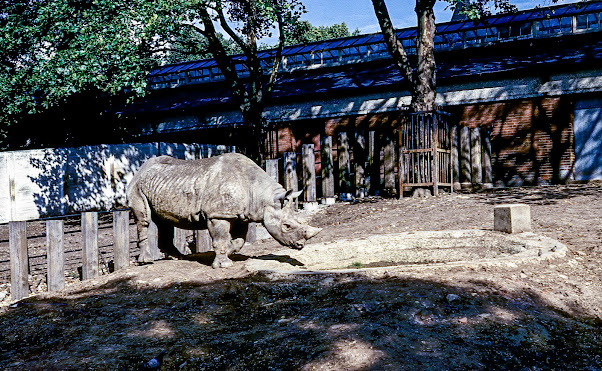Only after I read an excellent new article which arrived in my inbox last night did I realise the significance of a photograph I had taken at London Zoo in summer 1958. This is the photograph:
 |
| The pair of White Rhinoceroses at London Zoo, Summer 1958 |
For the monthly magazine Keeper Contact (February 2022) Douglas Richardson has written A Missed Opportunity: how zoos failed to save the northern white rhinoceros. With only two old females of the northern form of the White Rhino alive, it is extinct in the wild and just about effectively so in captivity. As well as providing cogent reasons for the failed attempts to breed the last of these animals in captivity he related the history of White Rhinos (Ceratotherium simum) kept in zoos and their origins. What I had not appreciated was that before 1962 all individuals of this species kept in captivity had been the northern form (or the subspecies cottoni if you really must). Only after 1962 did the southern form become relatively common in zoos as its numbers increased from very low levels in the wild and it bred freely in captivity.
The penny then dropped. The pair of White Rhinos I had taken a photograph of at London Zoo in 1958 were Northern White Rhinos. The northern form was found in southern Chad, Central African Republic, southern Sudan, north-east Democratic Republic of Congo and Uganda. Douglas Richardson explained that the pair at London Zoo, the first ever in the U.K., had been captured by John Seago, one of the main dealers in East African mammals in the 1950s and 60s, in Uganda. They arrived at London Zoo on 25 July 1955. Few will now remember why they were given the names Bebe and Ben but the husband-and-wife stars of the immensely popular radio and, later, television sitcom Life with the Lyons were Bebe Daniels (1901-1971) and Ben Lyon (1901-1979) and the Zoo was never slow in attaching the names of celebrities to animals in order to attract the paying public.
In the 1950s, the Zoo’s rhinos were housed in the Deer and Cattle House; the White Rhinos were in the southern end paddock where they could be seen from the end and the side. What became known as the Cattle Sheds, built in 1869, were replaced in the early 1970s by the New Lion House and in turn by the ‘immersive’ Land of the Lions exhibit in 2016.
As well as the White Rhino, the grazing rhinoceros of Africa, there was a Black Rhino (Diceros bicornis), the browsing rhinoceros of Africa, in another photograph I took. It was housed further along the row of paddocks of the Deer and Cattle House, also with suitably reinforced fence lines and a rather pathetic concrete pond.
 |
| Black Rhinoceros, London Zoo, Summer 1958 |
Asked whether I have seen a White Rhinoceros in the wild I have to say no but then stop the conversation by continuing, ‘But I have been close enough to milk one’ which is what David Jones, then the vet at Whipsnade, the late Jim Linzell and I did. Indeed the mother in her stall was completely unconcerned by our presence and what we were doing. Taking milk samples from a White Rhino was deemed safer than taking milk from many a dairy cow.
————————————
Richardson D. 2022. A missed opportunity: how zoos failed to save the northern white rhinoceros. Keeper Contact, Number 180 (February 2022) 11-17.

No comments:
Post a Comment